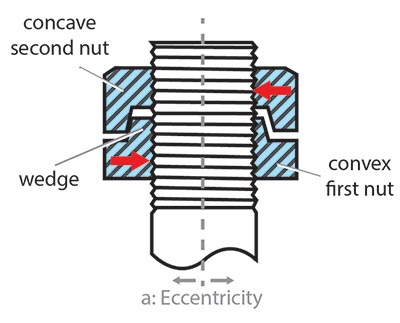Staytite Ltd is renowned for supplying high-quality products and reliable solutions to customers. Epitomising this commitment is the Hardlock nut range – for which Staytite supplies under licence and has been the sole European distributor since 1982.
To create a powerful self-locking force that offers a secure fastening solution for extreme vibration environments, the Hardlock nut utilises the wedge locking principle.
The original wedge locking principle works by forcing a wedge into the gap between a cylinder and its surrounding tube to make it possible to create a powerfully locked assembly (Figure 1).

By creating matching key grooves in both the nut and bolt, and then using a hammer to drive a wedge into those grooves, it provides a powerful self-locking effect (Figure 2).

The Hardlock solution is to use two nuts to play the roles of the hammer and wedge respectively. A small eccentricity in the sliding part of the convex top of the lower nut acts as the wedge. When the concave upper nut is tightened, the effect produced is exactly the same as that produced by a hammer driving in a wedge. Moreover, it is much more effective to use a screw as this makes it very easy to force the wedge into place (Figure 3).

The installation process of the Hardlock (Figure 4) involves the tightening of the lower nut (1), and then the installation and tightening of the upper nut (2) by hand. The result is a gap being created, which is a tightening margin used to provide the self-locking effect. During installation, the nuts can also be applied in the opposite order – installing the concave nut (2) first and then tightening the convex nut (1) – which results in exactly the same self-locking effect.

Tightening the upper nut (2) with a wrench generates torque, which allows the self-locking effect to be felt by hand. This means that users can make use of this feedback to set the torque value as required. At this time, the powerful self-locking effect is intrinsic – regardless of whether or not there are any gaps between the upper and lower nuts, which means the user can rest assured that the nut is securely tightened (Figure 5).

The Hardlock nut solution is predominately used where there are high-levels of vibration and is applicable across a variety of industries, including rail, civil engineering, structural engineering, wind turbines, shipbuilding, automotive and aerospace. The Hardlock nut also successfully meets the testing requirements of multiple vibration and impact tests, including NAS3350 and NAS3354. These tests further certify that the Hardlock nut provides effective locking force and remains in a stable locked condition.
To underline the capabilities of the Hardlock nut, Staytite recently invested in a portable Junkers machine, which is approved to the required DIN specifications. “The portable Junkers machine is a fantastic bit of kit,” says David Cartledge, director of sales at Staytite Ltd. “It has been specifically designed so that it is easy to transport and can be used anywhere. This means that we can demonstrate the effectiveness of the Hardlock nut at the customer’s premises – either on the shop floor or in the boardroom.”
David continues: “Using the portable Junkers machine means that the customer has the opportunity to compare our Hardlock nut with the product they are currently using, as well as any other competitive products on the market. Within two minutes they get a comparable test benefit. There is also the option to change the program half way through, so that different speeds and the amount of movement within the joint can be altered – according to requirements.”
The Hardlock nut undoubtedly provides a unique level of security and quality, with Staytite determined to raise awareness of the product’s impressive holding capabilities. “We are actively looking for additional distribution partners in mainland Europe to help expand the reach of the Hardlock nut,” points out David. “We already have a distributor in Italy, but we are looking for further partners that are able to promote Hardlock nut, sell it and specify it.”
Staytite has also created a dedicated Hardlock website, so that customers can find out all they need to know about the capabilities of the Hardlock range.

Will joined Fastener + Fixing Magazine in 2007 and over the last 15 years has experienced every facet of the fastener sector - interviewing key figures within the industry and visiting leading companies and exhibitions around the globe.
Will manages the content strategy across all platforms and is the guardian for the high editorial standards that the Magazine is renowned.
Don't have an account? Sign Up
Signing up to Fastener + Fixing Magazine enables you to manage your account details.